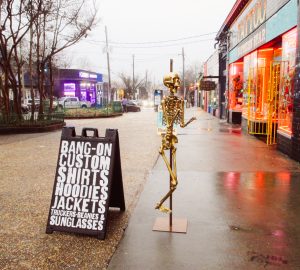Behind the green aprons: A candid conversation with a member of a Starbucks union

When the time came for his store to vote on unionizing, Xavier Jimenez knew what he would be voting for. Since our everyday work lives came to a screeching halt in March of 2020, workers across the United States have been finding themselves in the same situation as Jimenez. The pandemic has workers everywhere reevaluating the value of their labor and becoming increasingly aware of the leveraging power they hold. As of 2022, union election petitions have increased by 57% in the first half of the fiscal year and unfair labor practice charges have increased by 14%. Groundbreaking strides have been made in the unionization of an Amazon and multiple Starbucks locations across America. Workers are unionizing to use collective bargaining to argue for improvements across the board, like higher hourly wages, more hours and better safety protections. They want a say in what their working lives are like and they want an opportunity to hold a company that “talks of progressive values” accountable.
I talked to Jimenez, who previously worked at a Starbucks in South Carolina and is currently employed at the Willow Lawn location in Richmond, Virginia, about his store’s process of organizing the union efforts.
The Great Resignation, or the wave of workers quitting during the pandemic, is thought to be a shifting tide in the way we understand work. Food service workers in particular have been put on the front lines during all of this and it’s forcing many to reconsider their relationship with their work. This resonates with Jimenez; “I think my relationship in general with the work itself stayed the same, I was exploited beforehand and exploited during. I think the main change came in my understanding of how little the company cares about the lives of its employees.” Starbucks baristas had to work face-to-face with little to no personal protective equipment during a pandemic of airborne illness. “I remember that all the partners at the store that I was working at in South Carolina – where my parents live now, I was staying with them for a semester – were allowed to take a vote on whether we wanted to remain open during the height of the pandemic and a majority voted to close. Either the district or regional manager, I can’t remember specifically which one, actually called individual partners to tell them how disappointed they were in us for choosing to close, literally in the middle of a deadly pandemic.”
Serving unmasked masses during a global pandemic was the straw breaking the camel’s back for many Starbucks workers and workers in the food industry in general. Jimenez doesn’t cite any particular tipping point for his pro-union position, but rather a sense of validation in the store’s overwhelmingly pro-union status. “I was always a pro-union person so I always knew that if a union came anywhere I worked that I would vote yes. I would even make jokes with my coworkers before Buffalo announced their petition to unionize where something would happen and I would say ‘Oh this wouldn’t happen if we had a union,’ but I never thought it would actually happen.”
There was, however, a situation that arose that solidified Jimenez’s pro-union decision. “Personally what pissed me off and made me really want to vote yes was that our manager decided to start cutting hours randomly and claimed it had to do with her only having a certain amount of labor hours to give out, even though Starbucks is a billion-dollar company. That pissed me off because I can survive if I don’t work my full availability, but there are people I work with who Starbucks is their only source of income. They pay for their own rent and they were struggling after all the hour cuts to be able to even survive. It was so upsetting that Starbucks could just randomly do that with no warning and we had no control over it. Part of my vote was definitely to stick it to them about that but also to have more control over our own hours.” Starbucks Corp. disclosed that Chief Executive Kevin Johnson’s total compensation totaled $20.43 million in 2021, up 39% from $14.67 million in 2020, yet partners that rely on their Starbucks income continue to have their hours cut.

When I told Jimenez that economists are referring to the recent Starbucks unionization as the start of a labor movement, he wasn’t surprised. “I know a lot about the labor rights movements of the past and about labor history in the country, so I know that there hasn’t been a labor movement at all in a long time, so I think that this is the start of a larger labor movement. I think that when Amazon took that vote, about a year or two ago in Alabama, that also could have been the start if they had won there. But since they lost I think we were given the opportunity to be a catalyst for the movement in the country.”
He also commented on the fact that Starbucks didn’t start anything that had not already been brewing for a long time. “The overall movement was started before the petitions were filed, I think that the great resignation was happening and I think that COVID-19 really highlighted a lot of the terrible working conditions people were put through and highlighted the inequality that hourly workers have to deal with. So I think all of that anger that the working class was starting to have about all of these things and was exacerbated by the pandemic bubbled over into unions coming back into play. I guess you could say that the union harnessed the anger of the masses and so these unionized stores are a response to larger unrest in the overall working class in America.”
Seeing that support for labor unions among college graduates has increased from 55% in the late 1990s to around 70% in the last few years, I asked Jimenez, who is a political science student at VCU potentially pursuing a Law degree, if he thought his pursuing education played a factor. “I don’t think that had that much of a factor in it. The sad thing is that so far in my school career, including university and k-12, there was barely any labor history taught. So most of the information I have on unions came from my own personal research into them and different readings I’ve done.” Jimenez noted that having a college education may, in some cases, prove to have the opposite effect. “I can see how having a college education would possibly make people anti-union. It’s funny because some of my coworkers and I were talking about Starbucks in DC possibly unionizing and we came to the conclusion that they might be some of the last ones to do it. Most of the people working in the DC Starbucks are actively seeking a degree of some sort, compared to stores in other places and will eventually become salaried workers. Those that are planning on going into law school or politics might become some of the people who are doing the union-busting. So I do think for some people degrees would play a factor in their decision but because I self-educated myself about everything to do with unions, it didn’t affect my choice.”
As of April 2022, the National Labor Relations Board is suing Starbucks for allegedly unfairly firing or retaliating against three union leaders from the company and is seeking injunctive relief and the reinstatement of these employees to the original positions with full pay. I asked Jimenez if there was any retaliation by Starbucks in his store after unionizing. “I think that retaliation comes in many forms. We didn’t have anyone fired or anything super evident like that. But there were some things, like how dress code all of a sudden became a huge issue. Before the union, you could more or less dress how you wanted, even if it was out of the dress code. But now, our general manager has made it clear that everyone has to always be in dress code or they’ll be written up.” A response from Starbucks may have come in more ways than one. “Starbucks’ all also have cameras. The cameras have literally never been used in our store – they’re always on but no one watches them. But after filing our petition, the district manager and our general randomly decided to start watching them again. They tell our shift leaders all the time that people are leaning on something, not doing work or sitting down on the floor for a second and tell them that they need to ‘watch it.’ It has kind of become like ‘Big Brother. So now everyone at my store is on our best behavior because we feel like they’re sniffing out reasons to try and fire people.”

Starbucks Workers United, a collective of Starbucks Partners organizing the union efforts, has pointed out the negative responses many employers have with unionizing within the workplace. Employers use anti-union rhetoric to tamp down unionizing efforts, citing ideas like, “With a union, you lose the ability to speak for yourself.” Jimenez does not think these ideas carry any water. “There’s absolutely no truth to this statement. Starbucks pays a PR firm and a law firm millions of dollars to come up with things like this.” According to Bloomberg Law, “Starbucks Corp. legal chief Rachel Gonzalez received more than $5.3 million in total compensation last year, one in which the company faced a growing movement to unionize workers at its coffee shops.” “They’ve said a ton of stuff like this to us throughout our campaign and before we even petitioned. They would say ‘the union is going be a middleman’ and ‘after you have a union you legally can’t talk to the store manager without a union rep.’ These are just a few of the many falsehoods.” Jimenez sees the unions differently. “If anything, I think the exact converse of this statement is true. When every worker feels isolated and alienated from their coworkers, they probably won’t stand up for themselves. They feel like they’re just one person against upper management and a whole powerful company. With a union, it almost puts our voices on an equal playing field and gives the workers the actual chance to be heard and to make meaningful changes in our stores.”
According to SBWorker’s United, “a collective of Starbucks Partners across the Buffalo region who are organizing our workplaces with the support of Workers United Upstate, a union with experience building barista power,” without a union, workers are “at will” employees. This means the company can discipline or terminate a worker whenever they want, except for something that is a violation of federal law such as unlawful discrimination or firing for union activity. Unions can prevent unfair discipline or firings by negotiating a “just cause” clause in the collective bargaining agreement. This would protect all Starbucks workers from any unfair discipline or firing. I asked Jimenez if he has ever been witness to unjust firings at his store. “There haven’t been any unjust firings at my store, but I’ve heard about tons of them from other stores trying to unionize. The “just cause” clause is something we really are gonna fight for in our contract though. Especially working in Virginia, which is a fire-hire state, it’s scary to think that any one of us could be let go at any minute with no explanation and there’s nothing we could do about it. Starbucks could just decide they didn’t like an employee and tell them that they’re being fired and that partner would have no notice and would lose their only source of income just like that. This clause and the union, in general, would protect us from that.”
SBWorkers United elaborates on what unionized stores will be fighting for, citing that “unionized stores will have the right to negotiate a union contract and have a real voice in setting organization policies, rights on the job, health and safety conditions, protections from unfair firings or unfair discipline, seniority rights, leaves of absence rights, benefits, wages, etc”. Jimenez’s store is looking to do just that. “First is the just cause clause I mentioned. We’re also going for higher wages. Starbucks has made record profits in recent years, I think Starbucks’ net income was like a billion dollars just last fiscal quarter. The partners aren’t seeing any of that, even though it was our labor that created those record profits. For a company whose whole brand is how well it treats its employees, they don’t pay us like they care. I make $12 an hour and I believe it’s going up to $15 for baristas in June, but the only reason that’s increasing is because of the unionization effort. When unions come into a workplace, everyone benefits, even non-union stores. But I digress. We’re going to ask for $20 starting for baristas and like $25 for shift leaders— we know we’re not gonna get this, but it’s an ‘aim high, get low’ type of thing; our actual attainable goal is $17 for baristas and $20 for shifts. We also want a 50 cent to $1 pay increase for every year a partner is with the company. We’re hoping to get better sick and vacation leave. I think our current sick leave policy is that you get 1 hour of sick leave for every 40 hours worked, which is just ridiculous and I think it’s the same for vacation time, which you only start to get after you’ve worked there for a year.”
Jimenez’s store wants more for the partners than just livable wages. “We also want better equipment in our stores. Every Starbucks is kind of secretly falling apart right now. Half the time our machines don’t work, or they’re just very low quality. For example, we have ovens to heat food up that always stay at 425 degrees. They’re so crappy, they don’t heat the food properly, but Starbucks told us that the only way our store will get the new ones – that some other stores have – is if ours blow up. They’ve caught fire multiple times, but no explosion yet, so no new ovens. But it’s things like that, where we’re struggling to work with the cheap equipment that Starbucks gives us, so we want new equipment included in our contract.”
Tipping is also something the union has taken into consideration. “Another big thing is we’re going to try to get tips through the credit card machines. At other places, as you’re going to pay, it will ask if you want to leave a tip or not. We’ve been asking Starbucks to do that for so long now and they’re too lazy to upgrade their machines. We just lose out on that possible money, so we want to include credit card tips in the contract. We’re also hoping for a minimum tip out every week. Right now, the amount of tips you get every week is based on the amount of money we made through tips in a week divided by the total number of hours worked and then whatever that is is what you make in tips for every hour you worked in a given week. But it changes every week because it’s dependent on how much we get tipped. I work roughly 20-25 hours a week and based on how much we were tipped in a week, I’ve gotten $5 in tips but then sometimes it’s like $25. We want a minimum promised amount like, no matter what, we get $5 in tips every week for every 10-20 hours you worked that week. This is so people who rely on tip money, as well as their checks, have an idea of the minimum they’ll be making in tips every week. I’m sure there are plenty of other things we’re asking for but those are some of the main ones.”

At the end of our interview, I asked Jimenez if unionizing his workplace has made a difference in his working life. “I think it’s definitely more rewarding. I feel more connected to the job now that I know we’re gonna have the ability to be paid closer to what our labor actually entitles us to. I feel like whether or not it is sustainable is a maybe, only because the changes haven’t occurred yet. We just entered our bargaining stage which can take months. Buffalo, which was the first store to unionize, is still bargaining with Starbucks so long after they started. It’s because Starbucks is delaying and by law only has to have a bargaining meeting with the store’s bargaining committee once every three weeks, so it’s dragging along. But, I think once our bargaining is done and the changes are made, it will feel like a lot more sustainable job.”
Since our conversation earlier this week, new information regarding the Willow Lawn Starbucks in Richmond has come to light. Vice broke the news this morning that a supervisor kept his job even after pleading guilty to sexually assaulting a barista in November of 2021, while the victim was fired. The worker that assaulted the barista was transferred from an Ashland location to the Willow Lawn Starbucks in Richmond, Virginia, where he continued to work for nearly five months. It wasn’t until April of 2022 that Starbucks finally terminated the worker who assaulted the barista, five weeks after he pled guilty to aggravated sexual battery and after the court ordered that he register as a sex offender with Virginia state police.
The partners at Willow Lawn were not made aware that the worker had already pled guilty to aggravated sexual battery and was ordered by the court to register as a sex offender with the Virginia state police by the time he started working at their store. Jimenez says that he “only found out after [the worker] was finally fired, but we know that our store manager and our district manager knew the entire time and just let us work with him.” Multiple workers at the Willow Lawn store told Motherboard that “they thought Starbucks did not remove the worker who assaulted Claire quicker because they were focused on crushing the store’s union drive – telling them they could lose benefits if they vote in a union and posting anti-union messaging on store refrigerators.” Jimenez can confirm this, saying “it was clearly more important to them to stop us from unionizing over protecting us from a rapist working in our store.”
Jimenez thinks that this could have been avoided if the union was already in place. The store manager and district manager may not have loyalty to Starbucks executives, for fear of losing their jobs, in keeping the worker’s status a secret. Hopefully, having a unionized team would mean a safer working environment for all partners. It seems like the news of Starbucks’ actions at the Willow Lawn location will only stoke the fire of the unionization efforts. As of May 3, 2022, the Starbucks union has been victorious in 46 out of 54 contests or 85% of them, according to data from the National Labor Relations Board. This trend has the potential to spread into similar sectors. As of April 2022, Amazon workers at the JFK8 warehouse in Staten Island, New York City became Amazon’s first NLRB-recognized unionized workplace in the United States.
The Economic Policy Institute can sum up the reasoning behind unionizing, exactly what workers across the United States are fighting for. “The freedom of workers to join together in unions and negotiate with employers is widely recognized as a fundamental human right across the globe […] Unions are a dynamic and ever-evolving institution of the American economy that exist to give working people a voice and leverage over their working conditions and the economic policy decisions that shape these conditions. Collective bargaining is indispensable if we want to achieve shared prosperity […] Certainly, Americans of all ages, occupations, races and genders have a vested interest in making sure our economy works for everyone. To promote an inclusive economy and a robust democracy, we must work together to rebuild our collective bargaining system.” Workers far outnumber executives in this country and the time has come for them to use their voices as a collective and take back the power they are warranted.





















